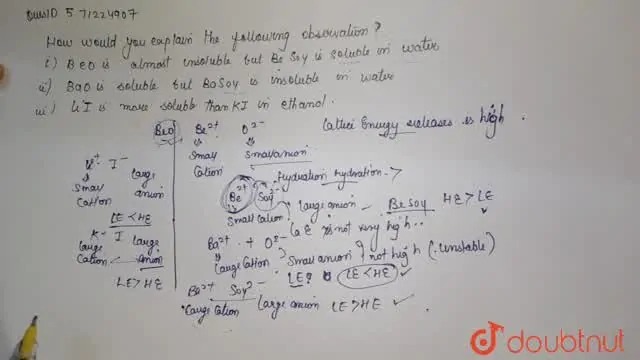How would you explain the following observations ?
(i) BeO is almost insoluble but BeSO4 is soluble in water
(ii) BaO is soluble but BaSO4 is insoluble in water
(iii) LiI is more soluble than KI in ethanol
(i) BeO is almost insoluble in water and BeSO4 is soluble in water Be2+ is a small cation with a high polarising power and O2− is a small anion The size compatibility of Be2+ and O2− is high. Therefore, the lattice energy released during their formation is also very high. When BeO is dissolved in water, the hydration enegy of its ions is not sufficient to overcome the high lattice energy. Therefore BeO is insoluble in water. On the other hand SO2−4 ion is a large anion. Hence, Be2+ can easily polarise SO2−4 ions, making BeSO4 unstable thus, the lattice energy at BeSO4 is not very high and so it is soluble in water
(ii) BaO is soluble in water, but BaSO4 is not Ba2+ is a large cation and O2− is a small anion. The size compatibility of Ba2+ and O2− is not high. As a result, BaO is unstable. The lattice energy released during its formation is also not very large. It can easily be overcome by the hydration energy of the ions. Therefore, BaO is soluble in water. In BaSO4,Ba2+ and SO2−4 are both large sized the lattice energy released is high Hence, it is not soluble in water
(iii) LiI is more soluble than KI in ethanol. As a result of its small size, the lithium ion has a higher polarising power than the potassium ion. It polarises the electron cloud of the iodide ion to a much greater extent than the potassium ion. This causes a greater covalent character in LiI than in KI. Hence, LiI is more soluble in ethanol.
Related Playlists
Similar Questions
MgSO4 is soluble while BaSO4 is insoluble in H2O. This is because :
View SolutionNa2SO4 is soluble in water while BaSO4 is insoluble. Which of the reason is correct about the above statement.
View SolutionBeSO4 is soluble in water but BaSO4 is insoluble.
Reason (R ): Lattice enthalpy of BaSO4 exceeds its hydration enthalpy.View SolutionWhy is I2 more soluble in KI than in water?
View SolutionEthylamine is soluble in water whereas aniline is almost insoluble. Why?
View SolutionExplain the following :
Ethene is insoluble in water but soluble in alcoholView SolutionGive reasons for the following :
MgCl2 is soluble in water but insoluble in acetone, while methane is insoluble in water, but soluble in acetone.View SolutionState True or False :
I2 more soluble in KI than in waterView SolutionThe solubility product of BaSO4 is 1.5×10−9. Find the solubility of BaSO4 in
pure waterView SolutionName three (i) sulphates (ii) Chloride insoluble in water and- two (i) oxides (ii) carbonates soluble in water
View Solution


